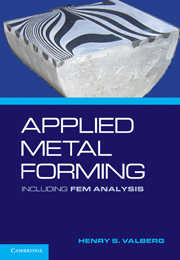Book contents
- Frontmatter
- Contents
- Preface
- APPLIED METAL FORMING
- 1 Characteristics of Metal Forming
- 2 Important Metal Forming Processes
- 3 FEA of Metal Forming
- 4 Theory
- 5 Reduction and Proportions of the Plastic Zone
- 6 Deformations from the Velocity Field
- 7 Technological Tests and Physical Simulation
- 8 Flow Stress Data
- 9 Formability and Workability
- 10 Friction and Friction Models
- 11 Thermal Effects
- 12 Experimental Metal Flow Analysis
- 13 Theoretical Methods of Analysis
- 14 Finite Element Analysis
- 15 FEA of Technological Tests
- 16 Forging
- 17 FEA of Forging
- 18 Extrusion
- 19 FEA of Extrusion
- 20 Rolling
- 21 FEA of Rolling
- 22 Drawing of Wire, Profiles, and Tubes
- 23 FEA of Wiredrawing
- 24 Sheet-Metal Forming
- Index
- References
2 - Important Metal Forming Processes
Published online by Cambridge University Press: 05 June 2012
- Frontmatter
- Contents
- Preface
- APPLIED METAL FORMING
- 1 Characteristics of Metal Forming
- 2 Important Metal Forming Processes
- 3 FEA of Metal Forming
- 4 Theory
- 5 Reduction and Proportions of the Plastic Zone
- 6 Deformations from the Velocity Field
- 7 Technological Tests and Physical Simulation
- 8 Flow Stress Data
- 9 Formability and Workability
- 10 Friction and Friction Models
- 11 Thermal Effects
- 12 Experimental Metal Flow Analysis
- 13 Theoretical Methods of Analysis
- 14 Finite Element Analysis
- 15 FEA of Technological Tests
- 16 Forging
- 17 FEA of Forging
- 18 Extrusion
- 19 FEA of Extrusion
- 20 Rolling
- 21 FEA of Rolling
- 22 Drawing of Wire, Profiles, and Tubes
- 23 FEA of Wiredrawing
- 24 Sheet-Metal Forming
- Index
- References
Summary
Although there are many different metal forming processes, in this chapter only some of the most important processes will be described. A more complete overview of metal forming processes is given elsewhere. A classification system that is useful for those who are not experienced metal formers will also be described.
Classification System for Metal Forming Processes
In Fig. 1.9, a sketch was shown in which the primary metal forming processes were organized among various common manufacturing methods. In Fig. 2.1, we have expanded the metal forming region downward, thus including the most significant metal forming processes. As seen from this figure, the processes at the lowest level of the diagram are commonly described by the name of the product created by that particular forming process.
Figure 2.1 also shows the important distinction between bulk-metal forming and sheet-metal forming. Bulk-metal forming is the shaping of bodies with concentrated mass, i.e., where the dimensions in each of the three orthogonal directions x, y, and z of the body are of similar size. Sheet-metal forming, on the other hand, is the forming of bodies with initial large extensions in two directions and small extension in the third direction, such as in a piece of sheet metal or a steel plate.
As mentioned before, sheet-metal forming is quite different from bulk-metal forming. In sheet-metal forming, a relatively thin, wide sheet is formed against a die. In this case, it is impossible to keep the workpiece inside a configuration of closed dies.
- Type
- Chapter
- Information
- Applied Metal FormingIncluding FEM Analysis, pp. 18 - 33Publisher: Cambridge University PressPrint publication year: 2010



